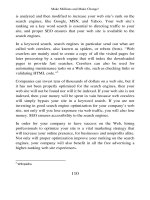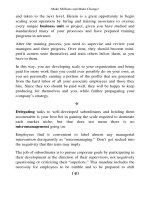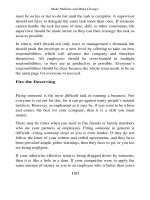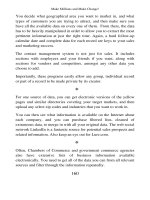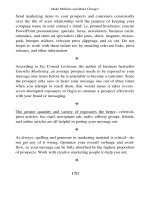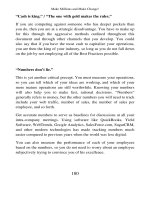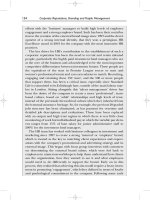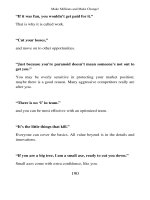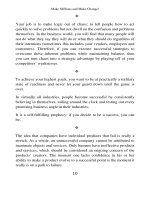Make Millions and Make Change 18
Bạn đang xem bản rút gọn của tài liệu. Xem và tải ngay bản đầy đủ của tài liệu tại đây (42.33 KB, 10 trang )
Make Millions and Make Change!
170
Send marketing items to your prospects and customers consistently
over the life of your relationship with the purpose of keeping your
company name in your contact’s mind: i.e. printed brochures, concise
PowerPoint presentations, specials, faxes, newsletters, business cards,
calendars, and other ad specialties (like pens, shirts, magnets, mouse-
pads, bumper stickers, relevant press clippings, and so on). Do not
forget to work with them online too by emailing relevant links, press
releases, and other information.
According to Jay Conrad Levinson, the author of business bestseller
Guerilla Marketing, an average prospect needs to be exposed to your
message nine times before he is amenable to become a customer. Since
the prospect only sees or hears your message one out of three times
when you attempt to reach them, that would mean it takes twenty-
seven attempted exposures to begin to saturate a prospect effectively
with your brand or messaging.
The greater quantity and variety of exposures the better—referrals,
press articles, fax, mail, newspaper ads, radio, affinity groups, friends,
and online articles are all helpful in getting your message out.
As always, spelling and grammar in marketing material is critical—do
not get any of it wrong. Optimize your overall verbiage and word-
flow, so your message can be fully absorbed by the highest proportion
of prospects. Work with creative marketing people to help you out.
Get Off Your Tuchus and Sell
171
Copious notes on each sales call and meeting should be kept in your
contact manager, so you can gauge the effectiveness of your sales
process and use that information to tailor your future messages.
Call clients back in a reasonable amount of time after meetings or send
letters and faxes, so they do not forget you. Ask for good days and
times to do follow-ups if they are generally hard to contact and ask
gatekeepers for the same information.
You must follow-up thoroughly on leads or else all the time and
money used on your background and introductory work is wasted, and
all leverage is lost! Reprioritize follow-ups according to your
perception of the prospect’s likelihood of bearing fruit. In this case,
your contact manager (often SalesForce.com and SugarCRM are the
best modern tools) once again proves to be critical, particularly its
calendar functions.
Do a lot of hand holding for demanding prospects. On average, this
will be worth the cost and effort for you and will lead to future strong
sales and referrals. If you can please the most demanding customers,
then you can please the not so demanding ones even more.
Establish long-term personal relationships with targets and clients to
the extent that it aligns with your goals. Make it easy instead of
overwhelming or overly complex for clients to buy what you are
offering. Then make sure to ask for the sale by saying, “What do you
think?”, “Are you ready?” and “Can I bring you the contract?” Then sit
quietly and let them answer; above all, listen to any objections you
will have to overcome.
If the answer is “no,” you will have to accept the rejection and move
on until your sales process suggests it’s time to call on that prospect
Make Millions and Make Change!
172
later, if ever. Do not be discouraged if your offer fails. However, when
a customer is ready to sign up, do not give him the opportunity to
change his mind—make the arrangements by phone, fax, and email
ASAP or setup a meeting with the contract in hand.
Statistical modeling will help you organize and analyze the tests of
your business activities. This can be especially effective in Internet
commerce where you can electronically measure the effects of new
navigation, graphics, text, partner programs, contextual advertising
strategies, and so on while dynamically improving your results on a
real time basis. Profits generated from your successful advertising tests
can fund additional, more permanent advertising investments. This is
the ideal.
When you make proposals to sell your services, they should often be
based on standard company templates, which are then customized to
meet each specific proposal at hand. They also must reflect the
accurate budgets involved as well as the reasonable timeframes for
benchmark activities. Proposals must be good-looking and accurate,
spell-checked, and grammatically correct.
Make an estimate of what the customers can spend since often what a
client wants may not be what she can afford. Detail her specific needs
so she knows the proposal is tailored for her.
Hit lots of leads simultaneously since only a minority of deals will
ultimately close, no matter how promising they look in the beginning.
Get Off Your Tuchus and Sell
173
Know precisely which services you wish to sell to each person based
on his likely requirements. Suggest solutions based on previous
customers in similar situations.
See what others in the prospect’s industry do for their solutions.
Know who your existing clients are and how to use them as references.
Consider doing a tag-team on deals, exposing the prospect to several
trustworthy, friendly, capable coworkers. This is often very successful.
When possible, use your prospects’ consultants to help close the deals.
Likewise, consultants might give you access to additional business
from their other customers if they appreciate your service. Consultants
are, therefore, leveraged prospects who should be considered high-
priority.
Once you have made a sale, check up on your customers and try to sell
them additional services while also attempting to get references.
Plant lots of seeds that could grow into good deals and opportunities
far in the future. Build a pyramid of referrals that will spin-off
business indefinitely.
Recommend add-on services. Say, “I will be in your building at two
o’clock, may I stop in for ten minutes to show you/tell you about…?”
This way, you will spread a wide net over various markets while still
getting the most out of each individual contact.
Consider offering your prospects a questionnaire, if that makes sense
for your product, and then take their feedback seriously to help
improve future offerings.
Make Millions and Make Change!
174
Document the good ideas and solutions that you learn in the field and
include them in your Best Practices or Standard Operational
Procedures master documents, so they are easily at hand when you
want to re-use them and teach them to others.
It is possible, despite your best efforts and investments in advertising
trials, that you have been unable to prove the effectiveness of
traditional advertising for your business. Advertising is a technique
that should be abandoned in favor of other investments if not directly
proven profitable; whereas, marketing is a broader process that
includes how you and your product are presented, so it cannot be
removed from your long-term business plan. You should have a sound
advertising strategy, which might include not advertising at all.
Since the advent of Google’s AdWords/AdSense platform and
Yahoo’s Overture platform, both leveraging the very profitable market
they have created for dynamic contextual advertising links, along with
older school applications like Advertising.com (now part of AOL) and
DoubleClick (now part of Google), traditional advertising has taken
new, innovative forms. Now, businesses, even with small budgets, can
more effectively reach their target markets and contend against larger
competitors through Internet advertising, which is currently best done
with text link advertising via online bidding processes.
Google has been the primary force in the democratization of
advertising. Suddenly taking brands global is not just for big
corporations with large-scale marketing budgets and strategies. Keep
your eye on a company called SpotRunner (.com) and its competitors,
which melds the better aspects of the Google targeting and bidding
platforms with more traditional, local television and Internet
